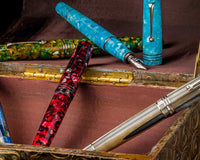Hello there. Would you like to play a game?
Take a quick break, and let's have some fun!
We have a few random tidbits of interesting facts here about our beloved writing instrument which, as a fountain pen enthusiast, we think you would appreciate. Take it like a QUIZ, and see how many of your answers are correct. Or just chill, and keep on reading.
The QUESTIONS are listed one after the other so that if you would like to give it a shot, write down your answers on paper, analog style, with your lucky fountain pen (of course) and see how you did from the separate ANSWERS that are given below.
RULES : Read one question, write one answer. Once you have written an answer down, there is no going back to revise your answer. Move on to the next question, and so on and so forth. Check how you did against the answers that follow. Tally your score.
TIP : This would be a fun activity as well to enjoy with your friends during fountain pen meets. Unleash that competitive spirit, compare your scores, and discover who truly is a fountain pen geek.
GOOD LUCK!

THE QUESTIONS
- What do you call the movement of ink in a pen that facilitates ink flow?
- Which Italian Renaissance artist is theorized to have designed a working fountain pen?
- What is known as the most expensive fountain pen in the world?
- What is the name of the special feed designed in 1894 that Parker is famous for?
- What tree was the traditional source of tannins found in medieval Iron Gall inks?
- What is the durable material first used in the manufacture of fountain pen bodies?
- What is a common chemical that can damage your fountain pens?
- What is commonly known as the “World’s Smallest Pen”?
- Which famous author of classic detective fiction favored the Parker Duofold fountain pen?
- What is the oldest known precursor of fountain pens?

THE ANSWERS
- CAPILLARY ACTION - This happens when any liquid, like ink, is confined within thin tubes. Two processes are involved. One is adhesion, where the ink molecules are attracted to the solid surface that they touch. Another is cohesion, where the ink molecules are drawn to each other. When the nib touches the paper fibers, themselves tubular in shape, the ink molecules are drawn out, each one attached to the other. As the ink flows out, air comes in through the slit in the nib and air channel in the feed, facilitating a smooth, continuous flow onto the paper’s surface.
- LEONARDO DA VINCI - His journals depict sketches of designs of a reservoir pen that employs both gravity and capillary action. Historians have noted the consistent contrast of handwriting found in his surviving journals, which is different from the characteristic fading pattern of handwriting typically resulting from using up ink and re-dipping a quill pen.
- FULGOR NOCTURNUS - This fountain pen was crafted by Tibaldi from Italy, using 945 black diamonds on its cap and most of the barrel. These dark, lush gems are the inspiration for its name, “Dark Glow”. In addition, it employs the Golden Ratio, a mathematical principle that maintains an exact ratio of 1.618 between 2 components of a single object, and is considered the most visually attractive proportion in nature and design. When the pen is capped, the measurement of the cap compared to the barrel follows this precisely. This fountain pen was auctioned off for $8,000,000.
- LUCKY CURVE - This innovative feed was designed to help prevent leaks. It involved a little curve at the underside of the feed that encouraged leftover ink to flow by capillary action back into the reservoir when the pen held upright.
- OAK - Traditional iron gall ink was generally made by mixing iron sulfate to a solution of tannic acid. Tannic acid was obtained through extraction from gallnuts, strange growths found commonly in oak trees, made by wasps to protect their larvae. These wasps secreted hormones that affected the tissue of the oak, stimulating the tree to form a protective coating around the developing larvae. Fermentation or hydrolysis of the extract released the tannic acid needed to produce a darker shade of ink.
- EBONITE - In 1839, Charles Goodyear invented a process that yielded a rigid and hardy material instead of an elastic substance. It was created by mixing latex with sulfur, and subsequently applying heat. The resulting consistency and color of the product were reminiscent of heartwood or ebony, hence its name.
- RUBBING/ISOPROPYL ALCOHOL - This household chemical is too harsh for fountain pens. It can mar the surface or even melt the plastic components. So simply, NO.
- WATERMAN NO. 000 - This miniscule eyedropper-filler with an ebonite body measures just over 1.5 inches long and ⅛ inch in diameter. It is also known as the “Doll Pen” as one rests within Queen Mary’s doll house atop the King's Library Table. It was made initially as a marketing tool by Waterman, to help salesmen open new accounts. The curiosity of the shop owner would lead to more time and interaction, often eventually ending in a sale. These small pens were made for sale by vendors only through special order.
- SIR ARTHUR CONAN DOYLE - This world-renowned English writer favored the Parker Duofold fountain pen for bringing Sherlock Holmes and his mysteries to life.
- REED PEN - In 3000 BC, Egyptians used these instruments to write on papyrus and parchment. Cut from marsh grass, particularly bamboo, one end was sharpened to serve as the pen’s nib, and the hollow body was filled with ink. The pen would then be squeezed to make the ink flow out.
How did you do? We hope you had fun!









1 comment
Do go go BK
GDGdjsvsksysbdbzmkGdvsnjxgdhztdgr kdgsvsbskissw1 zbßdßbxkdb5629ßbœö